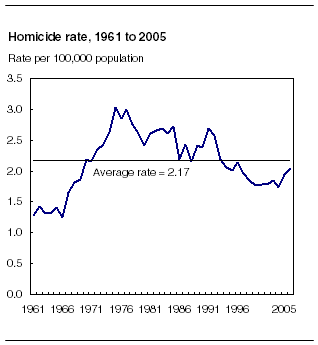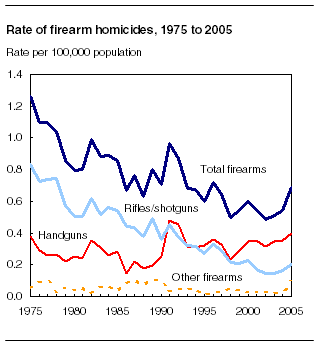Common menu bar links
Homicides
Archived Content
Information identified as archived is provided for reference, research or recordkeeping purposes. It is not subject to the Government of Canada Web Standards and has not been altered or updated since it was archived. Please "contact us" to request a format other than those available.

The national homicide rate increased for the second consecutive year in 2005 to its highest point in nearly a decade, after reaching a 30-year low in 2003. The number of homicides committed with a firearm rose for the third year in a row.
Police services reported 658 homicides last year, 34 more than in 2004. Of these, 222 were committed with a firearm, up from 173 in 2004.

Most of the increase in the homicide rate was driven by a jump in gang-related homicides, particularly in Ontario and Alberta. Two-thirds of gang-related homicides involved a firearm, usually a handgun.
Note to readersAggregate statistics on homicide in Canada for 2005 were first released in The Daily on July 20, 2006 as part of a wide-ranging report on crime. This report represents a more detailed analysis of the homicide data. The Criminal Code classifies homicide as first degree murder, second degree murder, manslaughter or infanticide. Deaths caused by criminal negligence, suicide, and accidental or justifiable homicide are not included. |
The national homicide rate peaked in the mid-1970s at 3.03 homicides per 100,000 population. It has generally been dropping since then, reaching a low of 1.73 in 2003. The 2005 rate was 2.04 homicides per 100,000 population.
The youth homicide rate reached its highest point in over a decade. A total of 65 youths aged 12 to 17 were accused of homicide in 2005, 21 more than the previous year.
The spousal homicide rate continues to drop. The 74 spousal homicides in 2005 represented the fourth consecutive annual decline.
This annual report contains, for the first time, a detailed analysis of homicide clearance rates among the nation's largest police services. Overall, it was found that among the 24,000 or so homicides that have occurred in Canada since 1961, 85% have been solved by police.
Firearm homicides up last three years but generally declining since mid-1970s
Police reported 222 victims killed by a firearm in 2005, 49 more than in the previous year and the third consecutive annual increase. By comparison, 198 victims were stabbed to death, the next most common method in 2005.
Over the past 20 years, shootings and stabbings have each accounted for about one-third of all homicides. Prior to 1985, however, shootings were much more common than stabbings.

The longer-term trend in the rate of firearms used to commit homicide has been declining since the mid-1970s. However, different trends are seen depending on the type of firearm used.
Prior to 1991, rifles/shotguns were used far more frequently than handguns. These proportions have since reversed themselves whereby, in 2005, handguns accounted for almost 6 in 10 firearm homicides compared to 1 in 4 for rifles/shotguns.
In 2005, handguns were used to commit 128 homicides, up from 112 in 2004. The number of homicides committed with a handgun has increased in six of the past seven years.
Since 1997, police reported that 83% of recovered firearms used to commit homicide were not registered. Where ownership could be determined, the accused owned the firearm in 60% of these homicides. Among homicides committed with a firearm, four out of every five accused persons did not possess a valid firearms certificate.
Increase in gang-related homicides
Police reported that 107 homicides were believed to be gang-related in 2005, 35 more than in 2004. Large increases in gang-related homicides were reported in Ontario, particularly in Toronto, and in Alberta. Part of the increase may be due to a slight modification in the way in which the data are captured.
In 2005, a revision was made to the Homicide Survey to identify those homicides in which gang-related activity was "suspected" by police, and not just "determined". For years prior to 2005, it is not known if "suspected" homicides were included in the totals. This modification may partially explain the increase in gang-related homicides over previous years.
Gang-related homicides accounted for 16% of all homicides in 2005. Two-thirds of these were committed with a firearm, usually a handgun.
Rate of youth accused of homicide highest in over a decade
A total of 65 young people aged 12 to 17 were accused of homicide in 2005, 21 more than the previous year. The rate of youth accused hit its highest point in more than a decade last year.
The increase in the rate of youth accused of homicide was in contrast to a 6% decline in the rate of youth crime, including a 2% decline in overall violent crime.
Despite year-to-year fluctuations, due to relatively small numbers, the youth homicide rate has remained fairly stable over the past 30 years.
Spousal homicide rate declining since mid-1970s
Police reported 74 spouses were killed in 2005, virtually the same as the previous year. Spousal homicide rates have been generally declining since the mid-1970s.
In 2005, spousal homicides accounted for about 16% of all solved homicides and almost half (47%) of all family homicides. As in previous years, the spousal homicide rate against women in 2005 was five times higher than the corresponding rate for men.
People living in common-law relationships were more at risk from their partner than those living in legal marriages. In 2005, the homicide rate of people living in common-law relationships was nearly five times higher than for those living in legal marriages.
Homicide rates highest in the West
Historically, homicide rates have generally been higher in the West than in the East. Last year, three of the four Western provinces (Saskatchewan, Manitoba and Alberta) recorded the highest rates among the provinces.
The rate in Saskatchewan, 4.33 homicides for every 100,000 population, marked its highest point in nearly three decades.
Quebec's homicide rate was down from 2004 and remained well below the national average. While the rate in Ontario was at its highest in more than 10 years, it was still below the national average.
Edmonton reported the highest homicide rate (4.29) among the nine largest census metropolitan areas (CMAs), and its highest rate since 1981 when statistics for CMAs were first available. Rates in Toronto and Calgary also increased to their highest levels in more than a decade. Montréal's rate was its lowest since 1981.
Despite a drop in 2005, Regina reported the highest rate (3.97) among the smaller CMAs, followed by Saskatoon. No homicides were reported for the CMAs of Sherbrooke, Trois-Rivières and Saint John.
Definitions, data sources and methods: survey number 3315.
The report Homicide in Canada, 2005, Vol. 26, no. 6 (85-002-XIE, free) is now available from our website. From the Publications module, under Free internet publications, choose Justice, then Juristat. A paper version (85-002-XPE, $11/$100) is also available.
For further information, or to enquire about the concepts, methods or data quality of this release, contact Information and Client Services (toll-free 1-800-387-2231; 613-951-9023), Canadian Centre for Justice Statistics.


 Table(s).
Table(s).